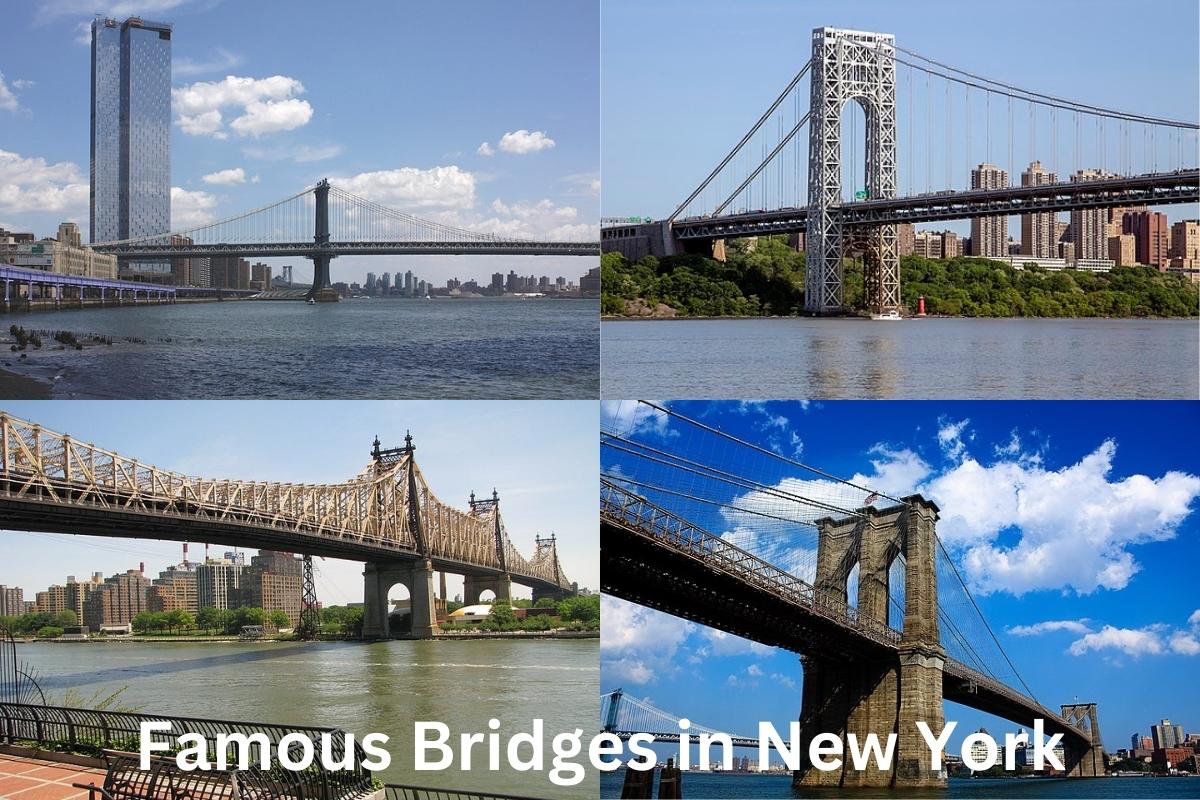New York’s bridges can give even it’s famed skyline a run for its money when it comes to recognizable landmarks.
The location of New York City on the coast, where the Hudson River and the Atlantic Ocean converge in a port that is naturally protected from the elements, is a defining feature of the city’s location.
Due to the city’s topography, it is necessary to have a large number of bridges in order to accommodate the millions of people that use roads to enter and exit the city each year.
Below are some of the most famous bridges in New York City that are crucial to its existence.
Famous Bridges in New York
1. Brooklyn Bridge
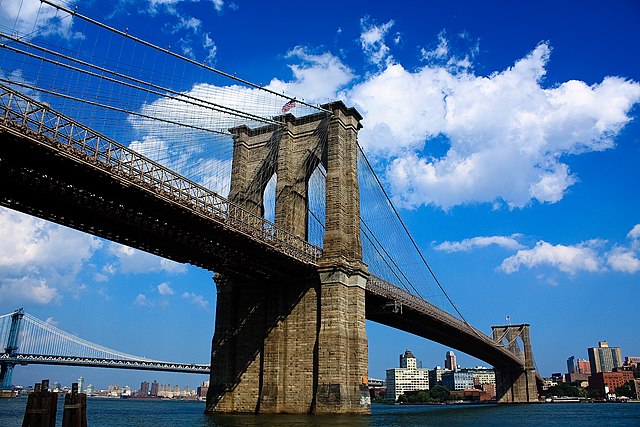
The Brooklyn Bridge is more than simply a bridge—a it’s significant part of New York’s and the country’s history. Opened in 1882, its 1,595-foot span and 276-foot height made it the world’s first steel-wire suspension bridge.
The East River Bridge or the New York and Brooklyn Bridge were its original names. The bridge was rechristened the Brooklyn Bridge in 1915.
John A. Roebling, with the assistance of other architects, is primarily responsible for the design and engineering of this magnificent structure. He was one of the 27 persons who lost their lives during construction, which is tragic.
More than 2,000 vehicles and 150,000 people may have used the bridge on its inaugural day.
Though, there were still whispers that the bridge wasn’t sturdy enough for vehicles and pedestrians. P.T. Barnum, a renowned circus performer, was invited to demonstrate the bridge’s durability by walking 21 elephants over it.
2. Manhattan Bridge
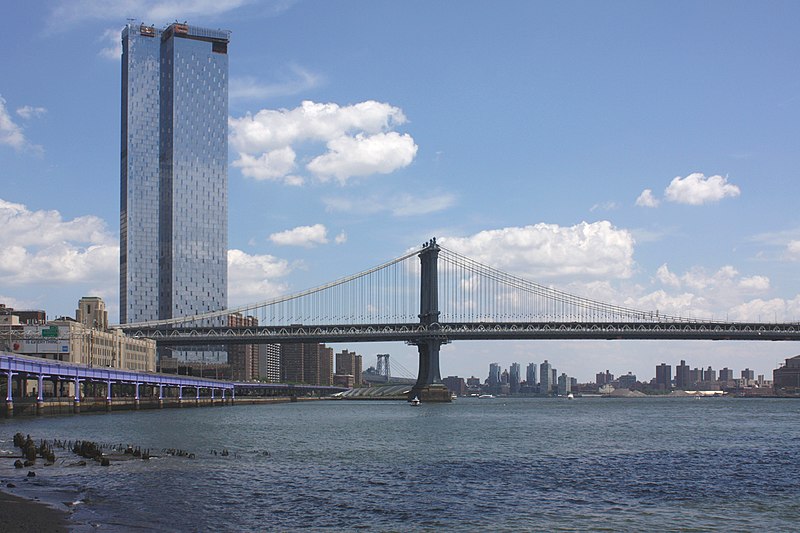
The Manhattan Bridge is a suspension bridge in New York City that connects Lower Manhattan at Canal Street to Downtown Brooklyn at the Flatbush Avenue Extension.
The primary span is 1,480 feet (451 meters) long, and the suspension cables are 3,224 feet (983 meters) long. The entire length of the bridge is 6,855 feet (2,089 m).
It is one of four toll-free vehicle bridges that link Manhattan Island to Long Island; the neighboring Brooklyn Bridge is somewhat farther downtown, and the Queensboro and Williamsburg bridges are to the north.
Leon Moisseiff designed the bridge, which was constructed by The Phoenix Bridge Company and opened to traffic on December 31, 1909.
It was the first suspension bridge to utilize Josef Melan’s deflection theory for deck stiffening, leading in the employment of a lightly-webbed weight-saving Warren truss for its construction.
It is regarded as the predecessor of contemporary suspension bridges and served as the basis for many of the world-record spans erected in the first half of the twentieth century.
3. Queensboro Bridge
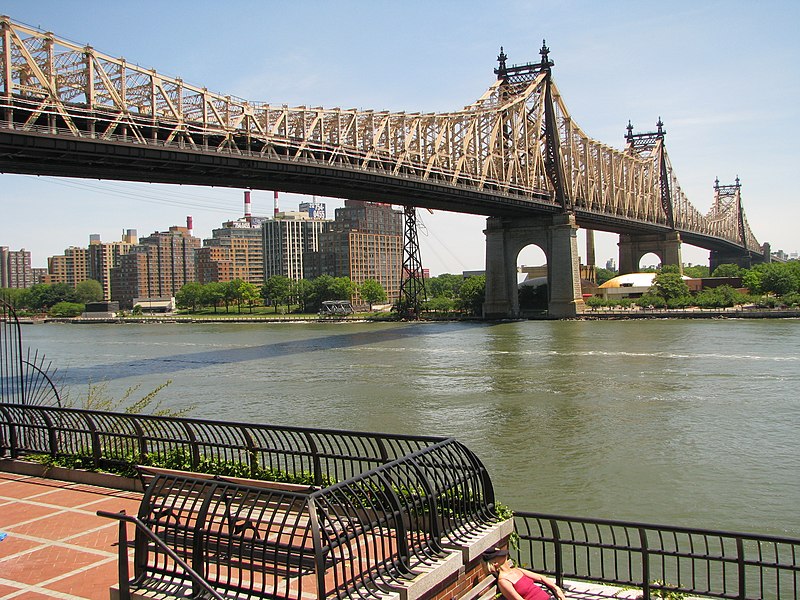
The Queensboro Bridge, formally known as the Ed Koch Queensboro Bridge, is a cantilever bridge that spans New York City’s East River.
It was completed in 1909 and links the borough of Queens’ Long Island City to Manhattan’s Upper East Side, traveling across Roosevelt Island.
Because its Manhattan end is situated between 59th and 60th streets, the bridge is also known as the 59th Street Bridge.
The Queensboro Bridge carries New York State Route 25 (NY 25), which ends at the bridge’s western terminus in Manhattan, and it also used to carry NY 24 and NY 25A.
The freestanding Roosevelt Island Tramway flanks the western segment of the Queensboro Bridge on its northern side. For a long time, the bridge was simply known as the Queensboro Bridge, but in March 2011, it was formally renamed in honor of former New York City mayor Ed Koch.
The Queensboro Bridge, together with the Williamsburg, Manhattan, and Brooklyn bridges to the south, is the northernmost of four toll-free vehicle bridges linking Manhattan Island to Long Island.
4. George Washington Bridge
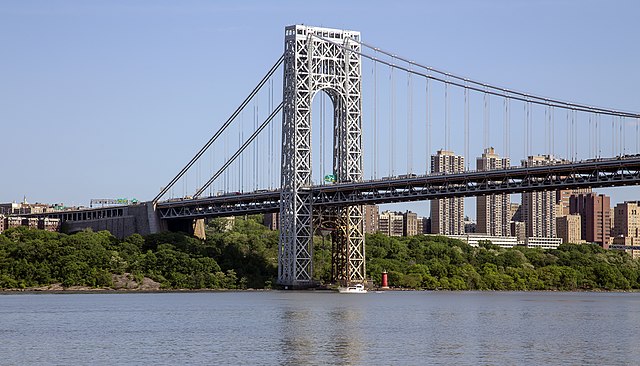
The George Washington Bridge is a double-decked suspension bridge that spans the Hudson River and connects the boroughs of Manhattan with Fort Lee in New Jersey.
The bridge is named after the first president of the United States, George Washington. In 2016, the George Washington Bridge carried more than 103 million cars, making it the busiest automobile bridge in the world.
Also Read: Famous Landmarks in New Jersey
It is owned by the Port Authority of New York and New Jersey, a bi-state government body that manages the port’s infrastructure.
During construction, the George Washington Bridge was known as the Fort Lee Bridge or Hudson River Bridge. It is also often referred to as the GW Bridge, the GWB, the GW, or the George.
The length of the George Washington Bridge is 4,760 feet (1,450 m), and its main span is 3,500 feet (1,067 m) (1,100 m). Until the Golden Gate Bridge built in 1937, it was the longest primary bridge span in the world.
Within the New York metropolitan region, the George Washington Bridge is a vital transportation artery. It features four lanes in each direction on the top level and three lanes in each direction on the lower level, for a total of 14 traffic lanes.
The bridge has a speed restriction of 45 mph (72 km/h). The top deck of the bridge also accommodates pedestrian and bicycle traffic.
The bridge carries Interstate 95 (I-95) and U.S. Route 1/9 (consisting of US 1 and US 9) over the river. US Route 46 (US 46), which runs fully inside New Jersey, finishes at the state line between New Jersey and New York, halfway over the bridge.
5. Williamsburg Bridge
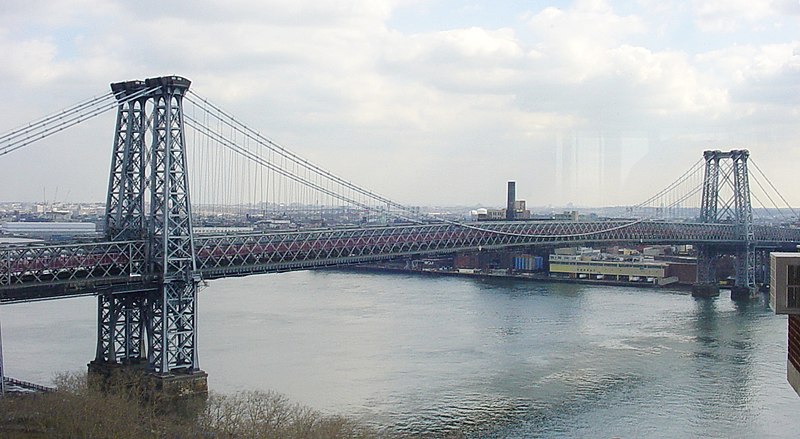
The Williamsburg Bridge is a suspension bridge over the East River in New York City that connects the Lower East Side of Manhattan at Delancey Street to the Williamsburg area of Brooklyn at Broadway near the Brooklyn-Queens Expressway (Interstate 278).
It was the longest suspension bridge span in the world from 1903 to 1924.
This bridge is one of four vehicle crossings between Manhattan Island and Long Island that are free of tolls. The other three are the Queensboro Bridge to the north, the Manhattan Bridge to the south, and the Brooklyn Bridge to the west.
The Williamsburg Bridge previously carried New York State Route 27A and was slated to carry Interstate 78 until the cancellation of the Lower Manhattan Expressway and Bushwick Expressway rendered the I-78 designation moot.
6. Verrazzano-Narrows Bridge
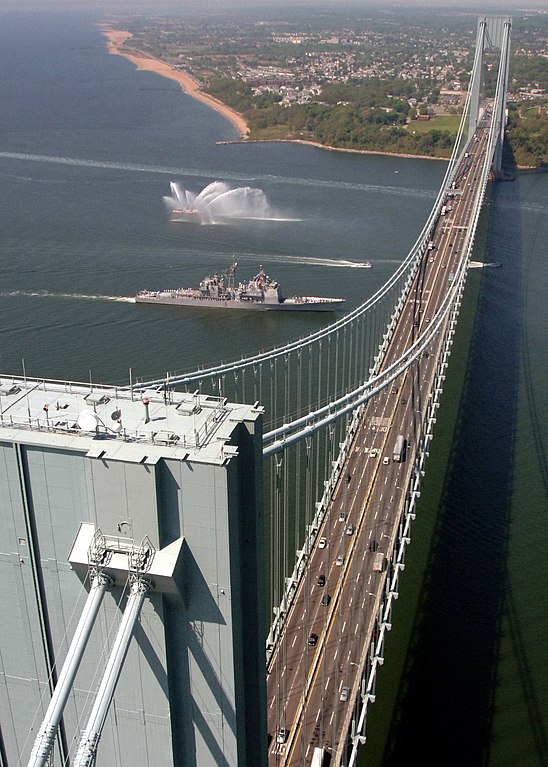
The Verrazzano-Narrows Bridge is a suspension bridge linking Staten Island and Brooklyn in New York City.
It crosses the Narrows, a body of water connecting Upper New York Bay to Lower New York Bay and the Atlantic Ocean. It is the only crossing of the Narrows that is permanent.
The double-decker bridge supports 13 lanes of I-278; seven lanes on the top level and six lanes on the lower level. The bridge is named after Giovanni da Verrazzano, the first European to visit New York Harbor and the Hudson River in 1524.
The middle span of the Verrazzano-Narrows Bridge is 4,260 feet (1.30 km; 0.81 mi). It was the world’s longest suspension bridge until the Humber Bridge in the United Kingdom surpassed it in 1981.
The bridge’s main span is the longest in the Americas and the eighteenth-longest in the world. Due to a mistake in the building contract, the bridge was spelt “Verrazano-Narrows Bridge” when it was formally named in 1960; the name was restored in 2018.
The Verrazzano-Narrows Bridge collects tolls in both ways; however, from 1986 until 2020, only westbound cars paid a toll in an effort to alleviate traffic congestion.
7. Robert F. Kennedy Bridge
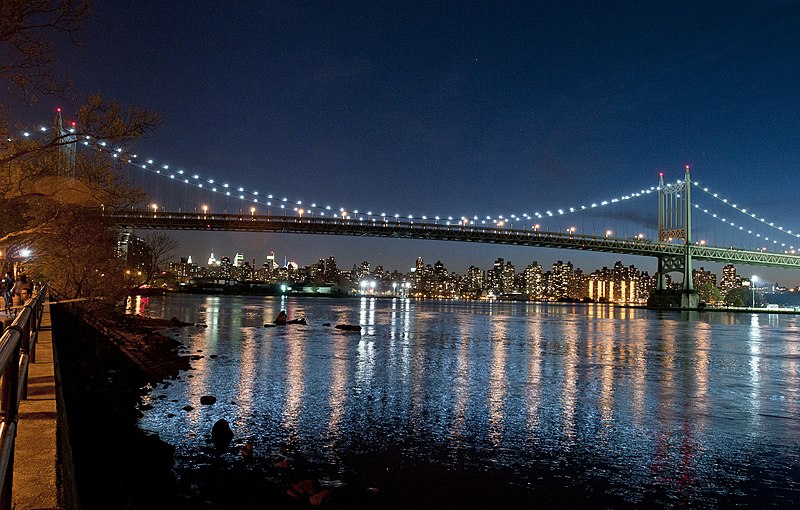
In New York City, the Robert F. Kennedy Bridge (RFK Bridge; originally and still frequently known as the Triborough Bridge) is a complex of bridges and elevated freeway viaducts.
The bridges connect Manhattan, Queens, and the Bronx boroughs. The viaducts traverse Randalls and Wards Islands, which were formerly two separate islands but are now connected by landfill.
The RFK Bridge is a toll bridge that crosses both Interstate 278 (I-278) and New York State Route 900G. It is connected to the FDR Drive and Harlem River Drive in Manhattan, the Bruckner Expressway (I-278), and the Major Deegan Expressway (Interstate 87) in the Bronx, and the Grand Central Parkway (I-278), and Astoria Boulevard in Queens.
These are the three principal bridges of the RFK Bridge complex.
The world’s tallest vertical-lift bridge spans the Harlem River and connects Manhattan to Randalls Island.
The truss bridge that spans Bronx Kill and connects Randalls Island with the Bronx.
The suspension bridge spanning Hell Gate (an East River strait) that connects Queens’ Wards Island to Astoria.
These three bridges are linked by a highway viaduct across Randalls and Wards Islands and 14 miles (23 kilometers) of service roads.
The viaduct incorporates a shorter bridge spanning the previous location of Little Hell Gate, which divided Randalls and Wards Islands.
In addition, the complex included a grade-separated T-interchange on Randalls Island, which meant that cars paid a toll at just one bank of tollbooths.
The tollbooths have been eliminated, and all tolls are now collected electronically at the bridge approaches.
8. Hell Gate Bridge
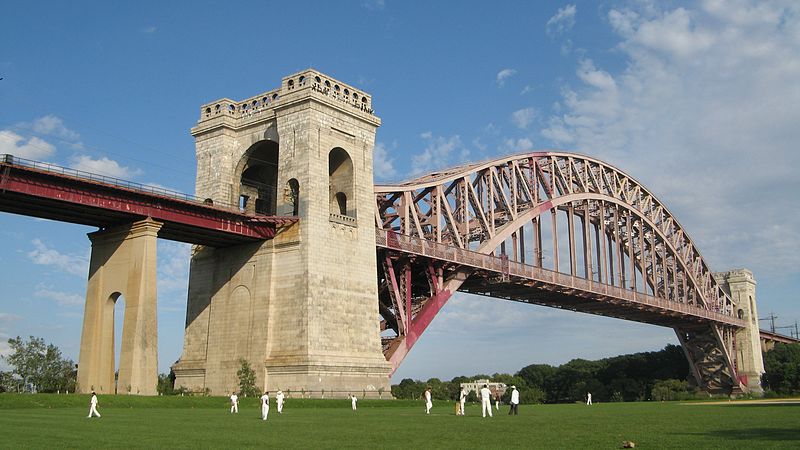
Originally known as the New York Connecting Railroad Bridge or the East River Arch Bridge, the Hell Gate Bridge is a 1,017-foot (310 m) steel through-arch railroad bridge in New York City.
Originally constructed for four tracks, the bridge now carries two tracks of Amtrak’s Northeast Corridor and one freight track between Astoria in Queens and Randalls and Wards Islands in Manhattan over the Hell Gate, a strait of the East River.
The Hell Gate arch is the biggest of the three spans that comprise the Hell Gate railroad viaduct. An inverted bowstring truss bridge with four 300-foot (91.4 m) spans spans the Little Hell Gate, a former strait that has been filled in, and a 350-foot (106.7 m) fixed truss bridge over the Bronx Kill, a former strait that has been constricted by fill.
The total length of the bridges, including approaches, exceeds 17,000 feet (3.2 miles; 5.2 kilometers). The Hell Gate Bridge inspired the designs of the Tyne Bridge in Newcastle, England and the Sydney Harbour Bridge in New South Wales, Australia.
9. Throgs Neck Bridge
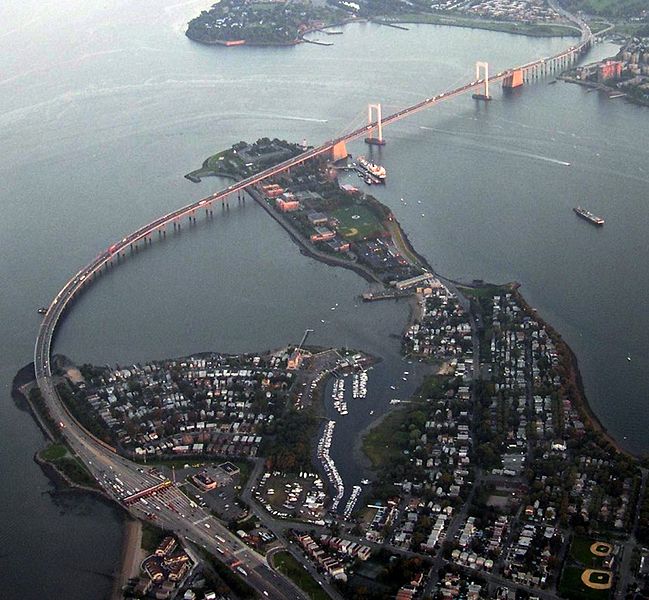
The Throgs Neck Bridge in New York City is a suspension bridge that carries six lanes of Interstate 295 (I-295) across the East River where it meets Long Island Sound.
The bridge links the Bronx neighborhood of Throggs Neck to the Queens neighborhood of Bay Terrace.
It was constructed to alleviate traffic on the Bronx–Whitestone Bridge, two miles (3.2 kilometers) to the west, and was inaugurated on January 11, 1961.
Additionally, the Throgs Neck Bridge is the furthest eastern crossing of the East River. Due to this and its closeness to I-95, it is the most convenient route from Long Island to New Jersey and points north via the George Washington Bridge.
The Throgs Neck Bridge is owned by the New York City government and managed by the Triborough Bridge and Tunnel Authority (TBTA), a subsidiary of the Metropolitan Transportation Authority (MTA).
10. High Bridge
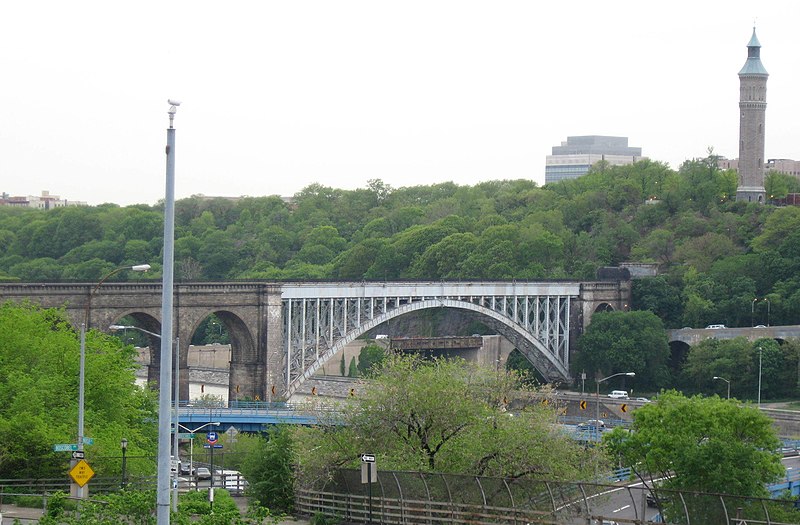
The High Bridge (formerly the Aqueduct Bridge) is the oldest bridge in New York City, having built in 1848 as part of the Croton Aqueduct and reopening in 2015 as a pedestrian walkway after a 45-year closure.
It is a 140-foot (43-meter) steel arch bridge that spans the Harlem River and links the New York City boroughs of the Bronx and Manhattan.
The eastern terminus is in the Highbridge neighborhood of the Bronx, at the western terminus of West 170th Street, while the western terminus is in Highbridge Park in Manhattan, roughly parallel to the terminus of West 174th Street.
High Bridge was constructed in 1848 with 16 separate stone arches. In 1928, a single 450-foot (140 m) steel bridge replaced the five wooden arches that crossed the Harlem River.
The bridge was closed to all traffic between the 1970s until 2009, when its repair started. On June 9, 2015, the bridge was reopened to walkers and cyclists.
The Department of Parks and Recreation of New York City operates and maintains the bridge.

